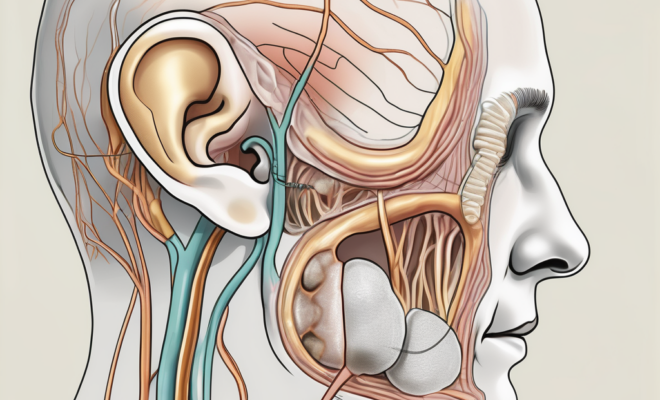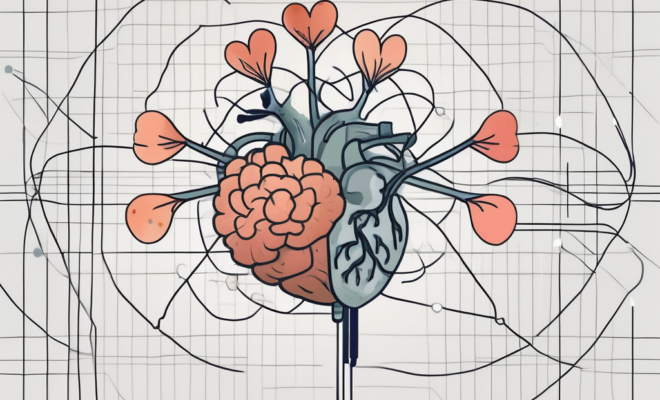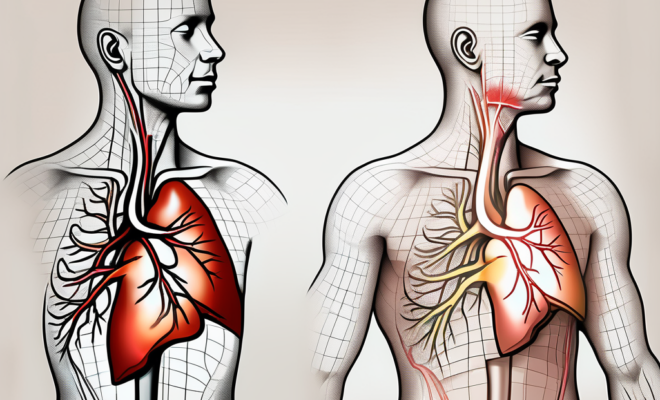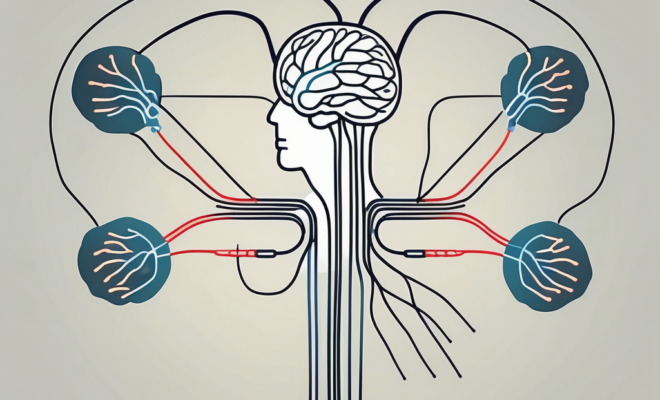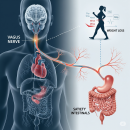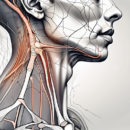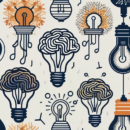The Role of the Vestibular Nerve in Balance and Spatial Orientation
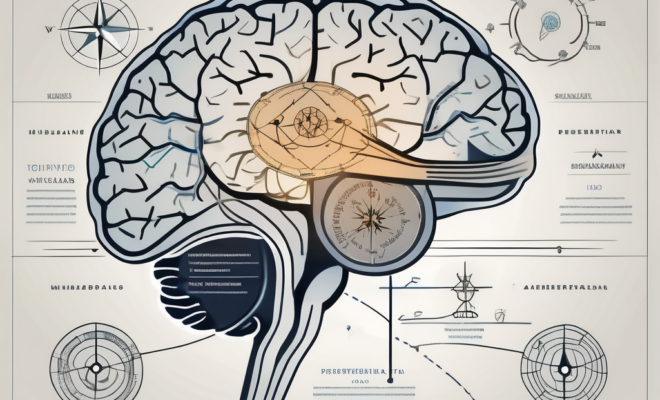
The vestibular nerve plays a crucial role in our ability to maintain balance and perceive spatial orientation. As someone who has dedicated years of research to studying the intricacies of the vestibular system, I am fascinated by the immense complexity and importance of this nerve.
Understanding the Vestibular Nerve
Before delving into the specifics of the vestibular nerve, let’s first understand its anatomy and function.
Anatomy of the Vestibular Nerve
The vestibular nerve is one of the two branches of the vestibulocochlear nerve, also known as the eighth cranial nerve. It originates from the vestibular ganglion, a cluster of cells located in the inner ear. From there, it extends into the brain and connects to various regions involved in balance and spatial perception, such as the brainstem and the cerebellum.
The vestibular nerve is a crucial component of the vestibular system, which is responsible for maintaining equilibrium and coordinating eye movements. It works in tandem with the semicircular canals and otolith organs in the inner ear to provide the brain with information about the body’s position in relation to gravity and motion. This intricate system allows us to perform complex tasks such as walking, running, and even maintaining posture while sitting.
Function of the Vestibular Nerve
The primary function of the vestibular nerve is to transmit information about head movements and orientation to the brain. Specialized hair cells in the inner ear detect changes in head position and movement, which then generate electrical signals. These signals are sent through the vestibular nerve to the brain, allowing us to maintain balance and perceive our position in space.
In addition to its role in balance, the vestibular nerve also plays a crucial part in spatial orientation and motion sickness. When the information received by the vestibular nerve conflicts with other sensory inputs, such as visual cues, it can result in dizziness and nausea. This phenomenon is commonly experienced when traveling by car, boat, or plane, where the vestibular system may perceive motion that is not congruent with what the eyes see, leading to discomfort.
The Vestibular Nerve and Balance
Our ability to maintain balance relies heavily on the information provided by the vestibular nerve.
The vestibular nerve is a component of the vestibulocochlear nerve, also known as the eighth cranial nerve. It is responsible for transmitting sensory information from the inner ear to the brainstem and cerebellum. This information is crucial for our sense of spatial orientation, motion detection, and balance control.
How the Vestibular Nerve Affects Equilibrium
The vestibular nerve plays a crucial role in our sense of equilibrium. It provides the brain with information regarding the position of our head in relation to gravity and the environment. By constantly monitoring head movements and sending signals to the brain, the vestibular nerve allows us to adjust our posture and make coordinated movements to maintain balance.
Additionally, the vestibular nerve works in conjunction with other sensory systems, such as vision and proprioception, to ensure accurate perception and control of body position. This integration of sensory inputs is essential for activities like walking, running, and even simple tasks like bending over to tie shoelaces.
Disorders Related to Vestibular Nerve and Balance
When the vestibular nerve is compromised or damaged, it can lead to various balance disorders that significantly impact daily life. Conditions such as vestibular neuritis, Meniere’s disease, and benign paroxysmal positional vertigo (BPPV) can all affect the functioning of the vestibular nerve, resulting in dizziness, vertigo, and difficulties with balance.
Individuals with vestibular disorders may experience symptoms like unsteadiness, nausea, and disorientation, making simple tasks challenging and affecting their quality of life. Treatment for these conditions often involves a combination of vestibular rehabilitation exercises, medication, and lifestyle modifications to help manage symptoms and improve balance function.
The Vestibular Nerve and Spatial Orientation
In addition to balance, the vestibular nerve also plays a crucial role in our sense of spatial orientation.
The vestibular nerve is a component of the vestibulocochlear nerve, also known as the eighth cranial nerve. It transmits sensory information from the semicircular canals of the inner ear to the brainstem, where it is processed to help us maintain our balance and spatial orientation. This intricate system allows us to perceive our body’s position in space and make adjustments to our movements accordingly.
The Vestibular System’s Role in Spatial Awareness
The vestibular system, which includes the vestibular nerve, works in conjunction with other sensory systems to provide us with a comprehensive perception of space. It helps us determine our body’s position and movement in relation to our surroundings. Without the input from the vestibular nerve, our ability to navigate and interact with the world around us would be greatly compromised.
Moreover, the vestibular system contributes to our sense of proprioception, which is the awareness of the position and movement of our body parts. This proprioceptive feedback, combined with input from the vestibular nerve, allows us to perform coordinated movements and maintain stability even in challenging environments.
Impact of Vestibular Nerve Damage on Spatial Orientation
Damage or dysfunction of the vestibular nerve can lead to issues with spatial orientation. Individuals with vestibular disorders may experience disorientation, difficulty with depth perception, and problems with spatial navigation. These challenges can significantly affect their quality of life and may require specialized interventions to mitigate the impact.
Furthermore, vestibular rehabilitation therapy is often recommended for individuals with vestibular nerve damage to help improve their balance, spatial orientation, and overall quality of life. This specialized form of therapy involves exercises and maneuvers designed to retrain the brain to compensate for the loss of vestibular function. By promoting central nervous system adaptation and enhancing sensory integration, vestibular rehabilitation can help individuals regain their confidence and independence in daily activities.
The Connection Between the Vestibular Nerve and the Brain
The intricate relationship between the vestibular nerve and the brain is a subject of ongoing research and exploration. The vestibular nerve, also known as the eighth cranial nerve or the vestibulocochlear nerve, plays a crucial role in transmitting sensory information from the inner ear to the brainstem. This information is essential for maintaining balance, spatial orientation, and coordinating eye movements.
Furthermore, the vestibular nerve is part of the vestibulocochlear nerve complex, which also includes the cochlear nerve responsible for hearing. This complex system enables humans to perceive and interact with the environment effectively, highlighting the intricate connection between sensory input and neural processing.
Vestibular Information Processing in the Brain
Upon receiving input from the vestibular nerve, the brain processes and integrates this information with data from other sensory systems to create a coherent perception of balance and spatial orientation. Researchers are unraveling the complex neural pathways and mechanisms involved in this processing, shedding light on the remarkable complexity of the vestibular system. The brain regions responsible for vestibular processing include the vestibular nuclei in the brainstem, the cerebellum, and various areas of the cerebral cortex.
Moreover, studies have shown that the brain’s ability to adapt and compensate for changes in vestibular input is crucial for maintaining postural stability and preventing falls. This adaptive capacity underscores the brain’s remarkable plasticity and its ability to reorganize neural circuits in response to sensory challenges.
Brain Disorders Affecting the Vestibular Nerve
Not only can issues with the vestibular nerve impact the brain’s processing of vestibular information, but certain brain disorders can also affect the functioning of the vestibular nerve itself. Conditions such as stroke, tumors, and multiple sclerosis can cause damage to the vestibular nerve, leading to a variety of vestibular symptoms and impairments. Understanding how these disorders disrupt the vestibular system is crucial for developing effective treatments and rehabilitation strategies to improve patients’ quality of life.
Furthermore, recent advancements in neuroimaging techniques, such as functional magnetic resonance imaging (fMRI) and diffusion tensor imaging (DTI), have provided valuable insights into the structural and functional changes in the brain associated with vestibular disorders. These imaging tools allow researchers to visualize and map the intricate connections between the vestibular nerve, the brainstem, and higher cortical areas, deepening our understanding of the neural mechanisms underlying vestibular processing and dysfunction.
Treatment and Rehabilitation for Vestibular Nerve Disorders
While the impact of vestibular nerve disorders can be significant, there are treatment options and rehabilitation techniques available to help individuals regain their balance and improve their spatial orientation.
Medical Interventions for Vestibular Nerve Damage
In cases where the vestibular nerve is damaged or dysfunctional, medical interventions may be necessary. These can include medications to alleviate symptoms such as vertigo or surgical interventions to address underlying causes, such as Meniere’s disease. It is crucial for individuals experiencing vestibular issues to seek professional medical advice and guidance.
When it comes to medications, there are various options available depending on the specific symptoms and causes of the vestibular nerve disorder. For example, anti-vertigo medications can help reduce the sensation of spinning or dizziness, providing relief to individuals who struggle with these symptoms. Additionally, medications that target inflammation or fluid imbalances in the inner ear can be prescribed to address underlying causes of vestibular dysfunction.
Rehabilitation Techniques for Vestibular Disorders
Physical therapy and vestibular rehabilitation can play a crucial role in helping individuals with vestibular disorders regain their balance and spatial orientation. These techniques focus on exercises and training to improve coordination, strengthen the vestibular system, and enhance postural stability.
One common rehabilitation technique is called gaze stabilization exercises. These exercises involve focusing on a stationary object while moving the head in different directions. By doing so, individuals can train their eyes and brain to work together more effectively, reducing dizziness and improving overall balance. Another technique, known as balance retraining exercises, involves practicing specific movements and positions to challenge the vestibular system and promote adaptation and compensation.
As a scientist deeply immersed in the study of the vestibular nerve, I am continually amazed by its complexity and significance in maintaining our balance and perception of spatial orientation. While vestibular disorders can present significant challenges, advances in research and medical interventions offer hope for those affected.
Researchers are constantly exploring new treatment options and rehabilitation techniques to further improve outcomes for individuals with vestibular nerve disorders. By understanding the intricate workings of the vestibular system and its connections to other sensory systems, scientists can develop targeted interventions that address the root causes of vestibular dysfunction.
With further exploration and understanding, we can continue to improve the lives of individuals with vestibular nerve disorders and enhance our knowledge of the fascinating world of balance and spatial perception. The intricate interplay between the vestibular system, the brain, and our perception of the world around us is a captivating area of study that holds immense potential for improving the quality of life for those affected by vestibular disorders.


